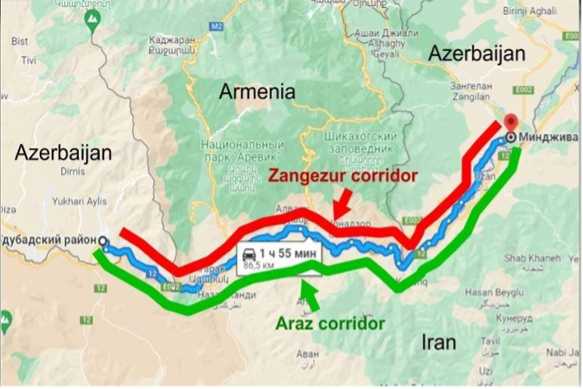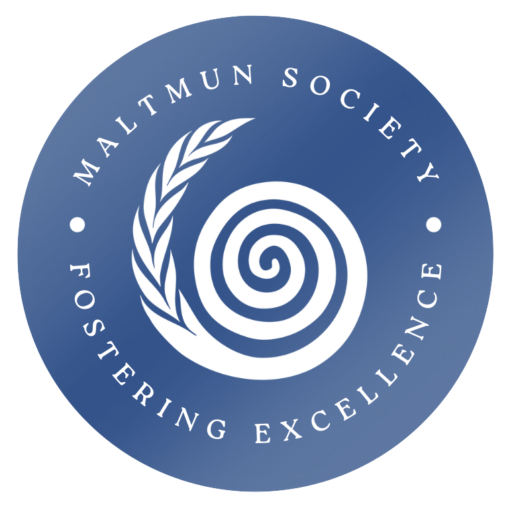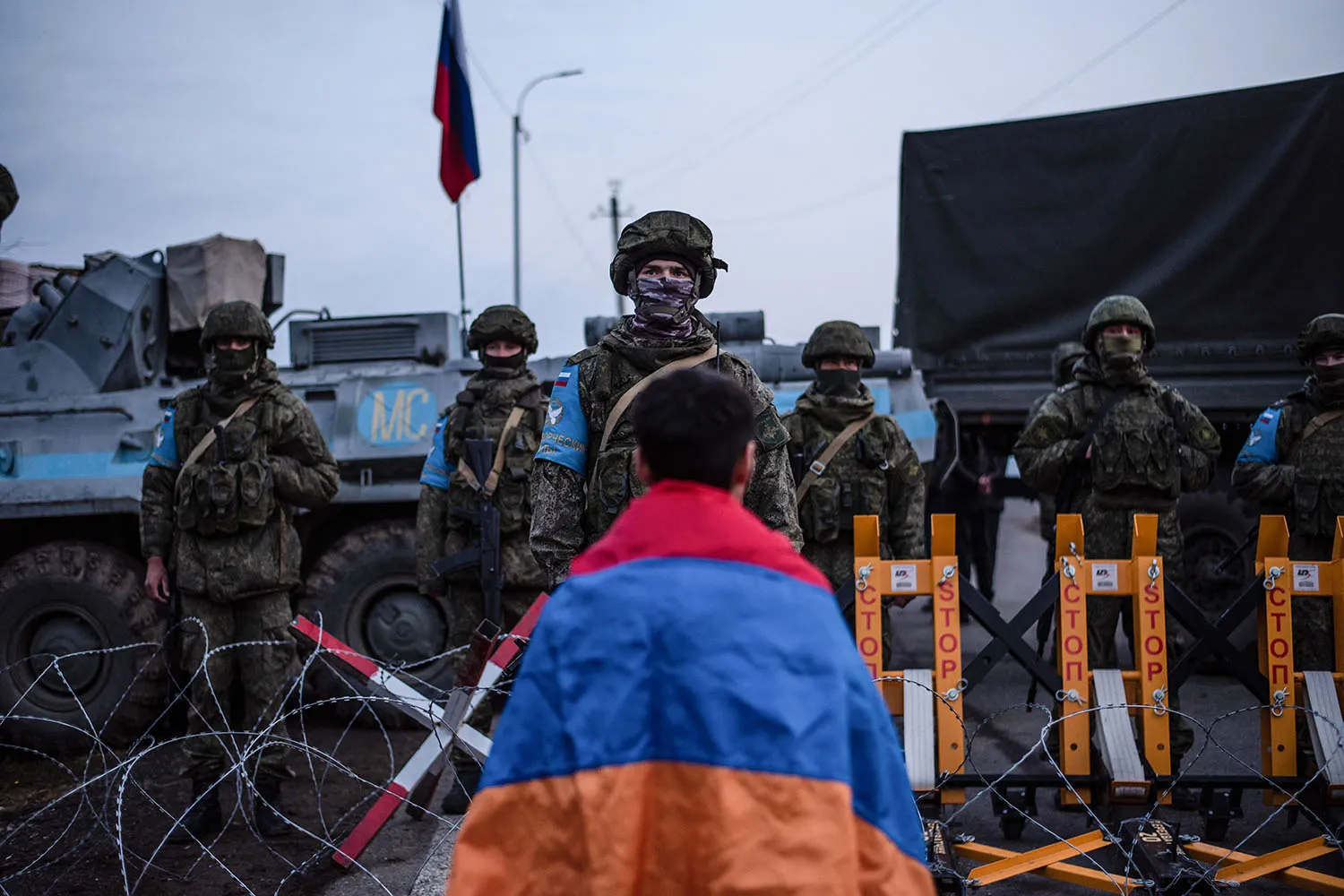Written by: Michael Gatt
The Nagorno-Karabakh conflict is developing into one of the world’s most debated disputes, rendering the country torn apart by clash; it is also largely forgotten by the international community. Global cooperation is urgently needed for Nagorno-Karabakh, but this endeavour is not easy seeing the history and developments of the conflict.
The Caucasus, a region often overlooked, was until recently home to one of the world’s—and Europe’s—frozen conflicts. A frozen conflict occurs when armed conflict ends without a peace treaty or political resolution that satisfies either party involved. These situations often lead to the creation of partially recognised states. Many post-Soviet frozen conflicts emerged after the USSR’s collapse.
Historical Background
The resettlement of Armenians in the territory of Azerbaijan is not a recent development. Rolling back the years to 1724, the Russian Empire regarded the Armenian Christian population as an essential element for them to secure access to the Persian Gulf, and therefore Peter I, the then Tsar, issued a decree which allowed Armenians to settle in a strip of Azerbaijani land along the Caspian Sea, seizing vast territories in the south of the Caucasus. Through this plan, Russian generals were instructed to “displace” the local Azerbaijanis, but these military reversals blocked other plans the Russians had for the resettlement of Armenians.1
Under the provisions of the Turkmanchai Treaty, 40,000 Armenians were resettled in Azerbaijan. Further to this, 90,000 Armenians who had been already living throughout the Ottoman Empire were also resettled in Azerbaijan following the conclusion of the Treaty of Edirne in 1829. These Armenian populations were primarily resettled in the territory of the Iravan, Nakhchivan, and Garabagh khanates, by Russian authorities. The issue of religious belief in addition to such displacement has been pertinent, as the Armenians, Christian, had been, as A.S.Griboyedov states “settled on the lands of Muslim landowners”, while also “forcing out the Muslims.”2
The colonisation of the Southern Caucasus (really Azerbaijan) by Armenia was closely followed by the Russian Empire, who were then highly dependent on their success. To the detriment of the Azerbaijani population, between 1828 and 1920, policies were implemented in order to forcibly exile well over two million Muslims, were even in two occasions, 1828 and 1854, Russia invaded Eastern Anatolia, retreating and returning with 100,000 Armenians who were relocated to the Caucasus replacing the fallen Turks and Azerbaijanis. Russia seized the Kars-Ardagan region in 1877-1878, once again forcing out Muslims and resettling 70,000 Armenians in their place.3 Following the devastation of World War I, approximately 400,000 Armenians from Eastern Anatolia were exchanged for 400,000 Muslims from the Caucasus. In total, between 1828 and 1920, approximately 560,000 Armenians resettled in Azerbaijan.4
Z.Balaian had stated “Its (Yerevan’s) residents are people who have come from other places. There are practically no true Yerevanites.”5 The inhabitants of Karabakh, then incorrectly referred to as Armenians, had already undergone the process of Armenianisation a couple of centuries before. Armenian author B.Ishkhanian wrote how the Armenians who reside in Nagorno-Karabakh are part aborigines and part descendants of ancient Albanians.6 Throughout all this, Russian Empire authorities continued to provoke confrontations in the Caucasus, with them specifically sparking conflict in 1905. Between the years 1907 and 1912, around half a million Armenians from Iran and the Ottoman Empire moved to the Erivan, Kars, and Elizavetpol regions, in which the majority of the population was made up of Azerbaijanis. This occured in order to strengthen Russia`s hold on the region and to control the inter-ethnic relations of the area.7 Furthermore, this separation of territory from Azerbaijan led to the settlement of Armenians in what became the Armenian Oblast, a territory which continuously expanded until the 20th century.
In 1918, Azerbaijan ceded a section of its Erivan district to the Armenian Republic, which was small in comparison with the districts which Azerbaijan seized by force of arms later between 1918 and 1920, which included Zangazur, parts of Garabagh, and Lake Geija (now referred to as Sevan). The Azerbaijani Soviet Socialist Republic was formed in 1920, and following this they did not demand the return of Azerbaijani territories, however, launched a ‘peaceful’ stage of land seizure, together with the assistance of the then Communist Russia and the Soviet Union. In 1921, Armenia legally acquired the Zangazur8 district and a large portion of the Gazakh district, essentially cutting off Azerbaijan from the Nakhchivan area.9 Similar ordeals took place with the Azerbaijani lands of Dilijan and Geija soon after in 1922. Onto 1969, and the Armenian Soviet Socialist Republic once more expanded their territory eastwards to the Gadabay district, at the detriment of Azerbaijan. Due to pressure from several authorities, a number of Azerbaijani villages in the Gazakh district ended up being transferred to Armenia.

The focus of the conflict lies more specifically in the Nagorno-Karabakh region. Known as the Nagorno-Karabakh Autonomous Region (NKAO), it occupied the south-east part of the Caucasus, including five administrative areas; Askaran, Gadrut, Mardakert, Martuni and Shusha. The population as estimated in the beginning of 1989 was that of 187,000, 73.4% (137,200) Armenians and 25.3% (47,400) Azerbaijanis.10 It’s also noteworthy that the official language for the former NKAO was in fact Armenian for anything relating to administrative purposes and in everyday life, as seen by Audrey Alstadt.11 Armenians were in the overwhelming majority in the staff of territorial and legislative organs, as well as in cultural and educational establishments. NKAO`s legal status, however, remained defined under the Constitution of the Azerbaijan SSR, and hence enjoyed administrative autonomy as a national-territory entity, eventually also under the the Constitution of the former Union of Soviet Socialist Republics (USSR) as well. Under the rule of the then Soviet Union, the region of Nagorno-Karabakh developed at a much faster pace than the rest of Azerbaijan, therefore exceeding the average rates of industrial output in the Republic. Such an advantage over all other regions in Azerbaijan meant that the NKAO experienced the most favourable conditions for preserving the identity of the Garabagh Armenians and, more broadly, the ethnic and cultural uniqueness of the region. Unlike other administrative-territorial units of Azerbaijan situated in mountainous areas far from the Republic’s capital, the Region had its own infrastructure for receiving television and radio programs. This development of the NKAO shows how it was done in conformity with the interests of the Armenian population, maintaining its image as a desirable destination for many generations of descendants of Armenians who had previously settled there.12
The Nagorno-Karabakh Autonomous Oblast was established in 1923, and was home to a 95% ethnically Armenian population, all falling within the territory of the Azerbaijan SSR. Further to this, in 1988 Nagorno-Karabakh passed a resolution within their regional legislature which declared their intention to join the Republic of Armenia, despite their legal location being inside Azerbaijan. While tensions on topics such as ethnicity had been growing in prior decades, armed conflict ensued such a resolution. The USSR was later dissolved in 1991, with Armenia and Azerbaijan achieving statehood shortly after within the same year. With this, Nagorno-Karabakh declared independence, and therefore a full-scale war erupted. The first Karabakh war took place between 1988 and 1994, and resulted in approximately thirty thousand casualties and displaced hundreds of thousands of people. By 1993, Armenia had taken control of Nagorno-Karabakh and occupied around 20% of Azerbaijan’s territory. In 1994, Russia brokered a ceasefire, known as the Bishkek Protocol, which left Nagorno-Karabakh de facto independent with a self-proclaimed government in Stepanakert, though it remained heavily dependent on Armenia for political, military, and economic support. The bilateral acceptance of the proposed ceasefire in 1994 remained formally in force until recent times.
The Organisation for Security and Cooperation in Europe (OSCE) has led several negotiation and mediation efforts, and in 1994 helped establish the Minsk Group, co-chaired by the United States, Russia, and France, though have not yet yielded a permanent resolution to address the conflict. The group has at least successfully led ceasefires, however, territorial disputes remain pertinent as ever.13 Between 1994 and 2020, deadly attacks and incidents occurred intermittently with the use of heavy weaponry and attack drones. In April 2016, four days of intense fighting along the line of separation shook the region, resulting in hundreds of deaths on both sides and signalling the potential for further conflict. This foreshadowing became reality in September 202014 when full-scale war erupted. After six weeks of brutal combat, a ceasefire brokered by the Russian Federation took effect in the early hours of November 10th. While the agreement fell short of establishing a clear or lasting peace, it did bring an end to the deadliest fighting the region had experienced in nearly three decades. Over 7,000 military personnel and approximately 170 civilians were killed, with many more wounded.

As part of the ceasefire agreement, Azerbaijan regained full control of the seven districts surrounding Nagorno-Karabakh, which had been held by Armenian forces since the previous war, and also secured a substantial portion of Nagorno-Karabakh itself. The remaining part of Nagorno-Karabakh is now patrolled by a Russian peacekeeping force, although it continues to be governed by self-proclaimed local authorities. The front line became immensely more volatile following the great conflict in the second Karabakh war of 2020. Prior to the war, Armenia and Azerbaijans military were hundreds of metres apart, but following the war the distance was reduced to a mere 30-100 metres. This also meant that Azerbaijan reclaimed most of the territory it lost two decades prior, as well as isolating Artsakh from Armenia, leaving Armenia with only a portion of Karabakh and meaning that Armenia and Artsakh were only connected via what was referred to as the Lachin corridor, supervised by Russian peacekeepers. Russia`s peacekeeping mission outposts were situated along the main roads of areas in Nagorno-Karabakh which are populated with Armenias, while the November 2020 agreement established a Russian-Turkish monitoring centre inside of Azerbaijani territory, in close proximity to the front line. September 2022 served as a reminder that the conflict is still tense, with escalation rising in the borders of the two countries, similarly resulting in many detentions and casualties.15
Current Situation
The most recent developments in the region have occurred on 19th September in 2023, in which Azerbaijan launched a large-scale attack on the Armenian-populated region of Nagorno-Karabakh, despite it currently still internationally recognised as Azerbaijani land.16 Russian peacekeepers once more got involved to arrange for a ceasefire, in which Nagorno-Karabakh for the first time declared that they ceased to an exist as a sovereign state, despite previously being recognised by no one.17
Despite appearing in the eyes of the West as a frozen conflict, the renewed violence in the region appears more threatening than ever. The unrecognised Republic of Nagorno-Karabakh had proven itself durable in the face of this conflict up until September 2023, when Azerbaijan launched their fatal assault against them. For close to 30 years it remarkably sufficiently created institutions and established control over its territory while under threat from Azerbaijan.18
Despite this, these attacks are evidence of the change in power dynamics in the South Caucasus regions. It is evident that Azerbaijan is now prepared to take matters into their own hands by using force as well as a firm backing from Türkiye. Russia’s influence has massively diminished, and Azerbaijan`s growing importance in Europe as a key alternative hydrocarbon supplier has diverted the attention and goals of the West. The situation of Russia in the invasion of Ukraine has left them weakened in the region on several aspects, an Azerbaijan have exploited this by taking advantage by forming newfound alliances and partnerships.19
Timeline of Events
| 1724 | Russian decree allowing Armenians to settle in Azerbaijan |
| 1828 | Turkmanchai Treaty |
| 1829 | Russia invasion and retreat of Eastern Anatolia pt.1 |
| 1829 | Treaty of Edirne |
| 1854 | Russia invasion and retreat of Eastern Anatolia pt.2 |
| 1877-1878 | Russia seizing of the Kars-Ardagan region |
| 1905 | First Confrontations between Armenians and Azerbaijanis |
| 1914-1918 | First World War |
| 29th May 1918 | Government of Azerbaijan cedes part of the Erivan district to Armenia |
| 1918-1920 | Part of Garabagh, Zangazur and the Lake Geija district seized by Azerbaijan |
| 1920 | Formation of Azerbaijani Soviet Socialist Republic |
| 1920 | Formation of Armenian Soviet Socialist Republic |
| 1921 | Armenia legally acquires the Zangazur district and a large portion of the Gazakh district |
| 1922 | Armenia legally acquires Dilijan and Geija |
| 1923 | Nagorno-Karabakh Autonomous Oblast established |
| 1969 | Armenian SSR expand to the Gadabay district |
| 1988 | Nagorno-Karabakh resolution declaring intention to join the Republic of Armenia |
| 1991 | USSR dissolution |
| 1991 | Republic of Armenia and Republic of Azerbaijan founded |
| 1998 | Armenians demands Nagorno-Karabakh |
| 1988-1994 | First Karabakh War |
| 1994 | Armenia takes control of Nagorno-Karabakh |
| 12th May 1994 | Bishkek Protocol, Ceasefire |
| 1994-2016 | Intermittent Deadly Incidents in Nagorno-Karabakh |
| April 201 | Four days of intense fighting at the line of separation which shook the region, killing hundreds on both sides |
| 27th September 2020 | Second Karabakh War |
| 10th November 2020 | Ceasefire brokered by the Russian Federation |
| September 2022 | Escalation on the borders of Armenia-Azerbaijan |
| 19th September 2023 | Azerbaijani forces initiate a massive attack on Nagorno-Karabakh |
| 1st January 2024 | The end of the so-called Nagorno-Karabakh Republic |
- Karabakh, ‘The historical background of Nagorno Karabakh Conflict’ (Karabakh.org) <https://karabakh.org/conflict/the-historical-background-of-conflict/> accessed 12 August 2024. ↩︎
- A. S. Griboyedov Too Clever by Half. Letters and Notes (Baki, 1989) 387. ↩︎
- Justin McCarthy, ‘Armenian Terrorism: History as Poison and Antidote’, International terrorism and the Drug Connection (Ankara, 1984) 85-94. ↩︎
- Ibid. ↩︎
- Zori Balayan, Ojakh (Hearth) (1984) 110. ↩︎
- I. Aliyev, Nagorno-Karabakh: History, Facts, Events (Baki, 1989) 73-74 ↩︎
- Karabakh (n 2) ↩︎
- The Zangezur Corridor passing through Armenia, linking Azerbaijan with its Nakhchivan province, and the alternative Araz corridor through Iran. Source: CCBS ↩︎
- M. Ismailov, and E. Tokarzhevsky, Truth and Fiction. The Conflict in Nagorno-Karabakh (Baki 1990) 28. ↩︎
- Karabakh (n 2) ↩︎
- Levon Chorbajian, Patrick Donabedian, and Claude Mutafian, The Caucasian Knot: The History and Geo-Politics of Nagorno-Karabakh (Zed Books, London and New Jersey 1994) 13. ↩︎
- Ibid ↩︎
- Center for Preventative Action, ‘Nagorno-Karabakh Conflict’ (Global Conflict Tracker, 20 March 2024) <https://www.cfr.org/global-conflict-tracker/conflict/nagorno-karabakh-conflict> accessed 13 August 2024. ↩︎
- Photo 2: The results of the 2020 Nagorno-Karabakh war. Source: Wikimedia Commons ↩︎
- ‘The Nagorno-Karabakh Conflict: A Visual Explainer’ (ICG, 16 September 2023) <https://www.crisisgroup.org/content/nagorno-karabakh-conflict-visual-explainer> accessed 13 August 2024. ↩︎
- Ministry of Foreign Affairs, ‘Republic of Artsakh’ (8 January 2024) <https://www.mfa.am/en/> accessed 13 August 2024. ↩︎
- Christian Edwards, ‘Nagorno-Karabakh will cease to exist from next year. How did this happen?’ (CNN, 28 September 2023) <https://edition.cnn.com/2023/09/28/europe/nagorno-karabakh-officially-dissolve-intl/index.html> accessed 13 August 2024 ↩︎
- Walter Landgraf, and Nareg Seferian, ‘A “Frozen Conflict” Boils Over: Nagorno-Karabakh in 2023 and Future Implications’ (Foreign Policy Research Institute, 18 January 2024) <https://www.fpri.org/article/2024/01/a-frozen-conflict-boils-over-nagorno-karabakh-in-2023-and-future-implications/> accessed 13 August 2024. ↩︎
- Ibid ↩︎

